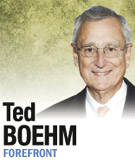Subscriber Benefit
As a subscriber you can listen to articles at work, in the car, or while you work out. Subscribe Now
 After each decennial census, the law requires redrawing the City-County Council districts. A decade ago, after a Democratic mayor vetoed a redistricting ordinance adopted by the Republican majority following the 2000 census, the Indiana Supreme Court rejected the partisan maps proposed by the two parties and adopted a neutral map that established the districts through the 2011 election.
After each decennial census, the law requires redrawing the City-County Council districts. A decade ago, after a Democratic mayor vetoed a redistricting ordinance adopted by the Republican majority following the 2000 census, the Indiana Supreme Court rejected the partisan maps proposed by the two parties and adopted a neutral map that established the districts through the 2011 election.
The 2011 election gave Mayor Ballard a second term but shifted the majority of the council to the Democrats effective in 2012. The lame-duck Republicans responded by authorizing over $200,000 in public funds to design a gerrymander that would restore a Republican majority.
In December 2011, this column predicted that any map drawn by the soon-to-be-minority Republicans would be redrawn in a heartbeat when the Dems took office. The mayor would veto that, throwing the process once again into the courts. So this proposal to reintroduce gerrymandering of the council would ultimately fail, but produce unnecessary expense and rancor. It would be “a step in the wrong direction and a waste of valuable time, resources and legislative energy.”
Well, here we are back in court, this time under a change in the Unigov law that assigns a redistricting challenge to five randomly selected superior court judges.
The Democrats seem to have a point that the 2012 council was required to redistrict. The Unigov law provides that the council “shall, by ordinance, divide ”the county into districts and that “this division shall be made during the second year after” a federal census.
Apparently, the supporters of the lame-duck redistricting argue that, because the mayor signed the 2011 ordinance on Jan. 1, 2012, the division was validly done in 2012.
But the council’s 2011 ordinance, not the mayor’s signing, appears to be “this division.” And why would the law permit a lame-duck council to tie the hands of the council most recently elected?
The Superior Court judges assigned to the case will have the benefit of the 2003 Indiana Supreme Court ruling that made clear that partisan concerns are not a proper factor for courts to consider in adopting any plan. Whatever their ruling, an appeal to the state’s Supreme Court is likely.
Despite recent turnover in the state Supreme Court, there is no reason to believe that court will reach a different result than it did in 2003. In the 26 years under the leadership of Chief Justices Shepard and Dickson, in the few cases where partisan interests were at stake, the court consistently ruled according to legal principles and often rejected the position advocated by the party of a majority of the court.
The December 2011 column contended that, because the court-ordered 2003 map was balanced, fair and met statutory standards of equal population, adherence to natural boundaries, etc., any redistricting should make only the minimal changes necessary to adjust for population shifts.
This approach preserves a fair election with several competitive districts as well as some safe for one party or the other. It also assures continuity and helps voters understand their district lines and who the candidates are.
The Democrats claim their map met this test and, if so, the courts may support it.
Regardless of what map is ultimately adopted, if the courts agree that the redistricting must occur in 2012, the 2011 map created with taxpayer money will prove to have been, as predicted, “a waste of valuable time, resources and energy.”
I hope future councils will spare us this turmoil and leave the outcome of elections to the voters, not the mapmakers.•
__________
Boehm is a retired Indiana Supreme Court justice who previously held senior corporate legal positions and helped launch amateur sports initiatives in Indianapolis. Send comments on this column to [email protected].
Please enable JavaScript to view this content.
